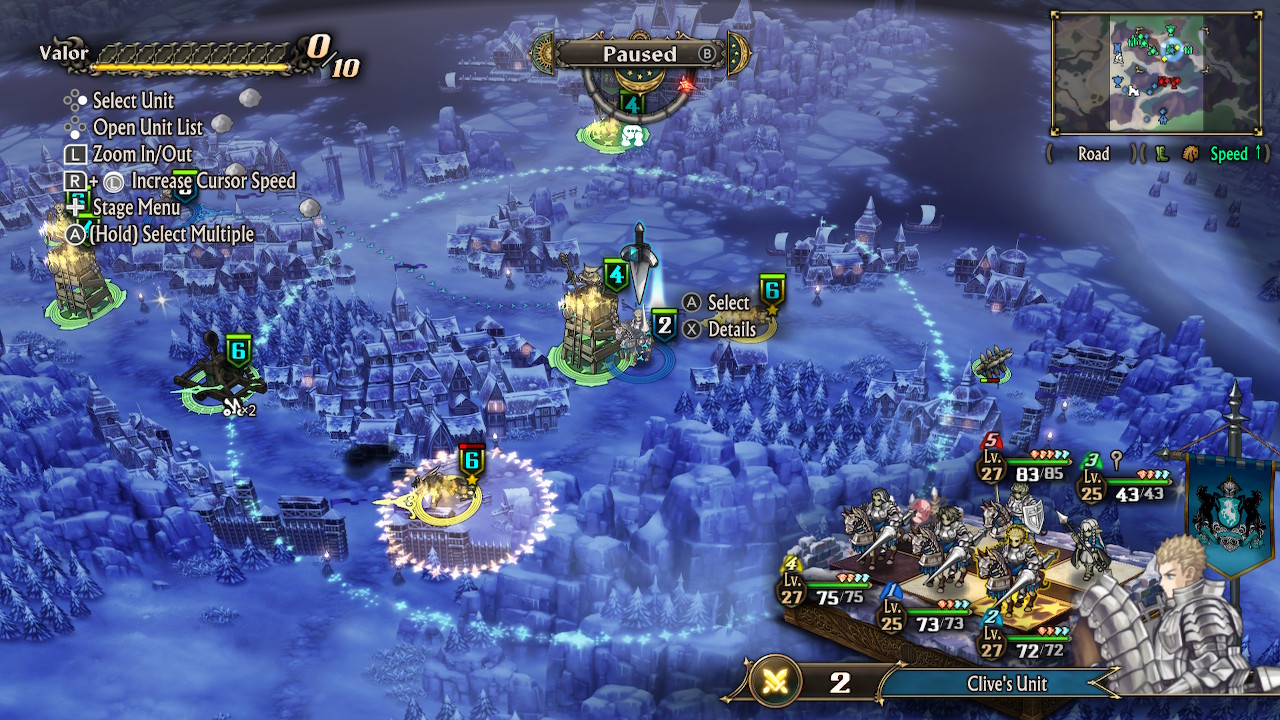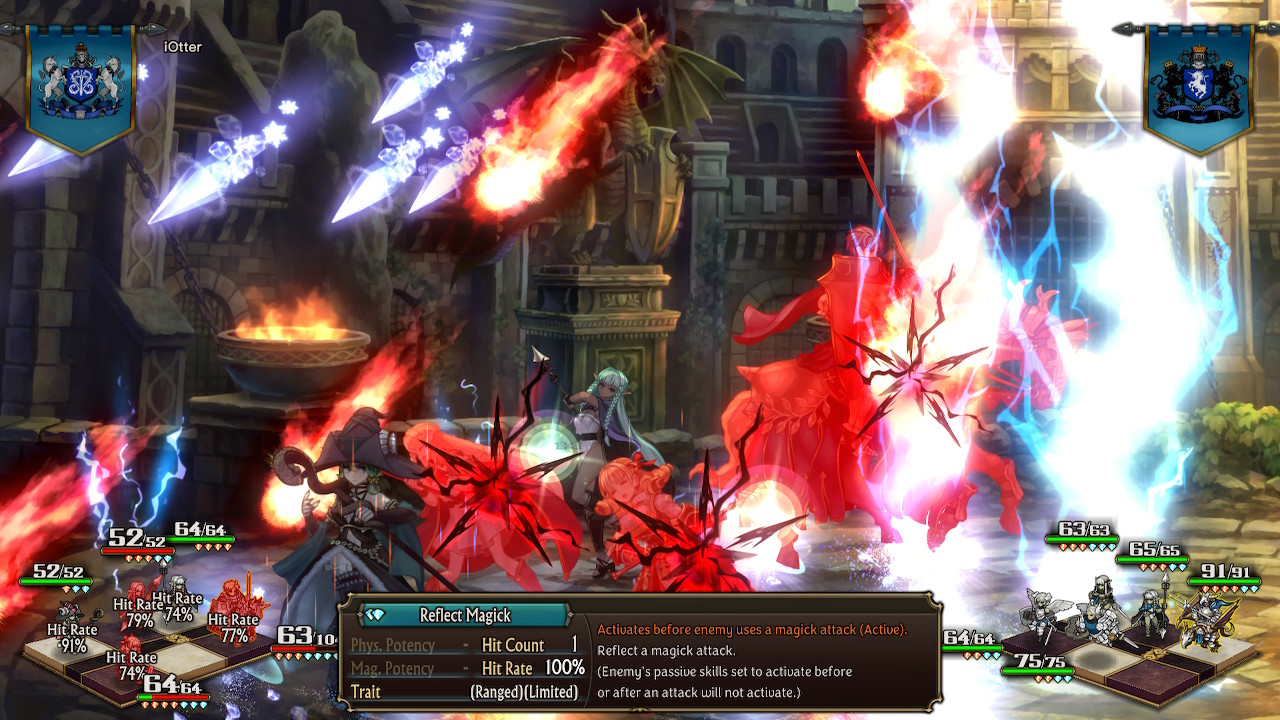I’m about to finish the excellent Unicorn Overlord, a fantasy strategy-RPG game available on consoles. While its writing is poor even by video-game standards, its mechanics are excellent, and nearly unique amongst modern games in the genre.
Central to those mechanics is the squad system, the focus of this article. This gives players a lot of scope to customise the squads into which the party is divided:
- First, by choosing the characters who go into each squad.
- Second, by setting up each character with skills, equipment, and programmable tactics.
Setting up synergies is fun…
Unicorn Overlord inherits its basic mechanics from Ogre Battle, the SNES classic:
- Each stage is its own real-time battle map.
- Instead of moving individual characters, the smallest controllable unit on the battle map is a squad of 3 to 5 characters. Eventually, the player can field up to 8 squads, for a total of 40 characters once fully upgraded.
- Characters come in many different classes, which determine their stats, skills, and available gear.
- Squads battle automatically, based on the tactics set up by the player.
Much of the fun comes from choosing, equipping, and configuring each squad’s characters so they complement each other. For example, this is my most powerful squad:

The key member of this team is Hilda, the wyvern rider. Her spear enables a skill that hits every member of the enemy squad at once. Normally this would take two turns to charge, but see below.
The two other back row characters support her: a witch adds ice damage and the “freeze” status effect to Hilda’s attack, and Selvie the druid gives her a second consecutive turn. This lets her instantly charge up, attack on her first turn, wipe out most of the enemy, and freeze the survivors.
Selvie also casts the Sandstorm spell, which adds the “blind” status effect to the enemy party. Against most enemies this is overkill — Hilda rarely leaves survivors — but better safe than sorry.
The two front-row characters are mostly there for utility, soaking incoming damage, and cleanup. Alain, the game’s main character, gives a bonus to “valor”, the resource used to call in more squads or activate special abilities. I swap the fifth character as needed.
For some time, the weakness of this squad was that it had no healer. I am experimenting with swapping a healer back in before the final battles.
… and so is unleashing them
How does the system play out in practice? I have a roster of squads, mostly designed for specific purposes:
- Some, like Hilda and friends above, are built for lethality. Their job is to go in, flatten the enemy squad with an all-targets attack on turn one, and then repeat with the next enemy.
- For instance, I’ve set up another squad along similar lines — it enables a witch to barrage the enemy with one of the most powerful spells in the game on turn one1.
- Some are meant for support, such as healing friendly squads or clearing obstacles from stage maps.
- Some are meant for mobility, with lots of fast, mounted or flying characters.
Now that I’m in the endgame, most of these squads are tried and tested. Some I use largely as-is, although I change individual characters’ gear when dealing with enemies who can inflict status effects. Others I continued to tweak late into the game, as new characters joined or as inspiration struck.
Level design does matter — I try to pick the right squads for the map. For example:
- On a stage centred around lifting the siege of a friendly city, I deployed my fastest squad to secure the palace and protect the NPC there.
- Similarly, I like to manoeuvre flying squads around terrain to eliminate ballista and catapult crews before they can threaten my main force.

While Unicorn Overlord’s main game is quite easy, I tweak squads more when playing the optional challenge content. This comes in two main flavours:
- Scripted coliseum challenges against squads with themed builds. Some of these were diabolically hard — beating them at a low level was probably the biggest impetus I’ve had to overhaul and tailor my squads.
- An “online” (really asynchronous) PvP mode where players can upload squads for others to challenge, and test their builds against other squads. Refining my tactics, practising my cheese builds, and trying to counter other people’s cheese builds has helped keep me entertained long after release. Whenever someone tries to hit me with an all-battlefield magic spell on turn one, it’s very satisfying to bring a character who can reflect magic.

Other benefits (and how Unicorn Overlord adheres to the Covert Action rule)
Taking a step back, it’s worth thinking how the Unicorn Overlord (and by extension, the Ogre Battle) squad system addresses a couple of design issues in the genre.
First, making the basic unit the squad rather than the individual character maintains a manageable limit on the number of units the player has to move around.
Second, it addresses the “large roster problem” in RPGs that only allow the player to use a few characters at a time. While the sheer number of characters in Unicorn Overlord (there are over 60 unique characters in the main game, plus generics) means some still end up on the bench, most have a chance to shine, even if only under specific circumstances.
While replicating this would be difficult, given how it forms part of Unicorn Overlord’s overall design, a handful of games probably would benefit from the squad concept. Expeditions: Rome features a large roster, a mix of story characters & (underutilised) generics, and a rather pointless legion battles minigame that amounts to several mouse-clicks and a few resources going up or down. Wouldn’t it have made more sense to group the available characters into squads for the legion battles?
(There is even a precedent for this — Suikoden III, another game with a massive roster, featured an army battles minigame that grouped up the recruited characters into squads.)
A final question is whether the additional complexity of squad setup is only possible because the battles are automatic. I think the answer is “yes”. In other words, Unicorn Overlord respects the Law of Conservation of Complexity and Sid Meier’s Covert Action rule (“one good game is better than two great ones”). I don’t think the game would work if every stage bogged down into manually controlled battles every time two squads fought2.
Conclusions
For over five months, Unicorn Overlord has kept me entertained, in no small part thanks to the squad system. Over that time, I’ve developed a powerful set of squads — both individually capable and effective as a group. They’ve taken me through most of the game’s content, including its challenge content, and I expect them to be able to handle the finale. After all, I’ve honed my cheese in the PvP meta. What final boss could rival that?
Enjoying this site? Subscribe to updates here: